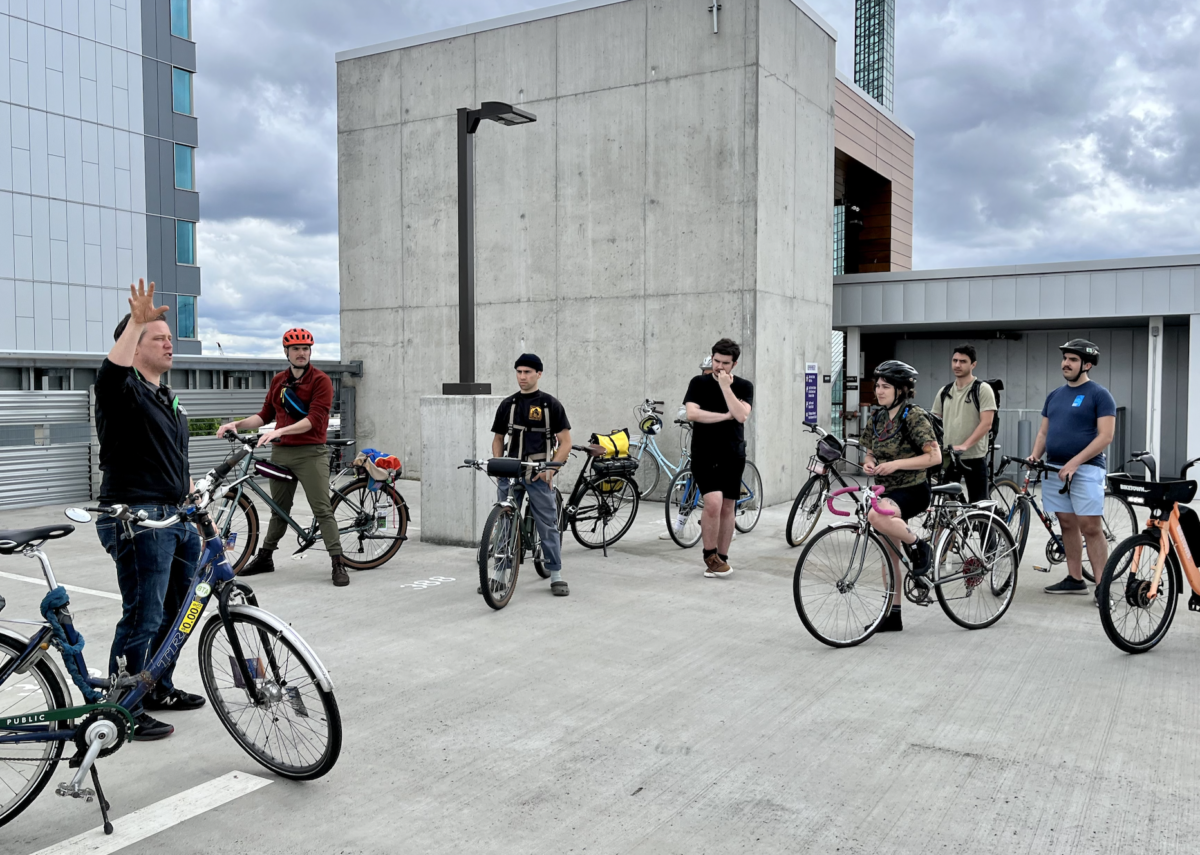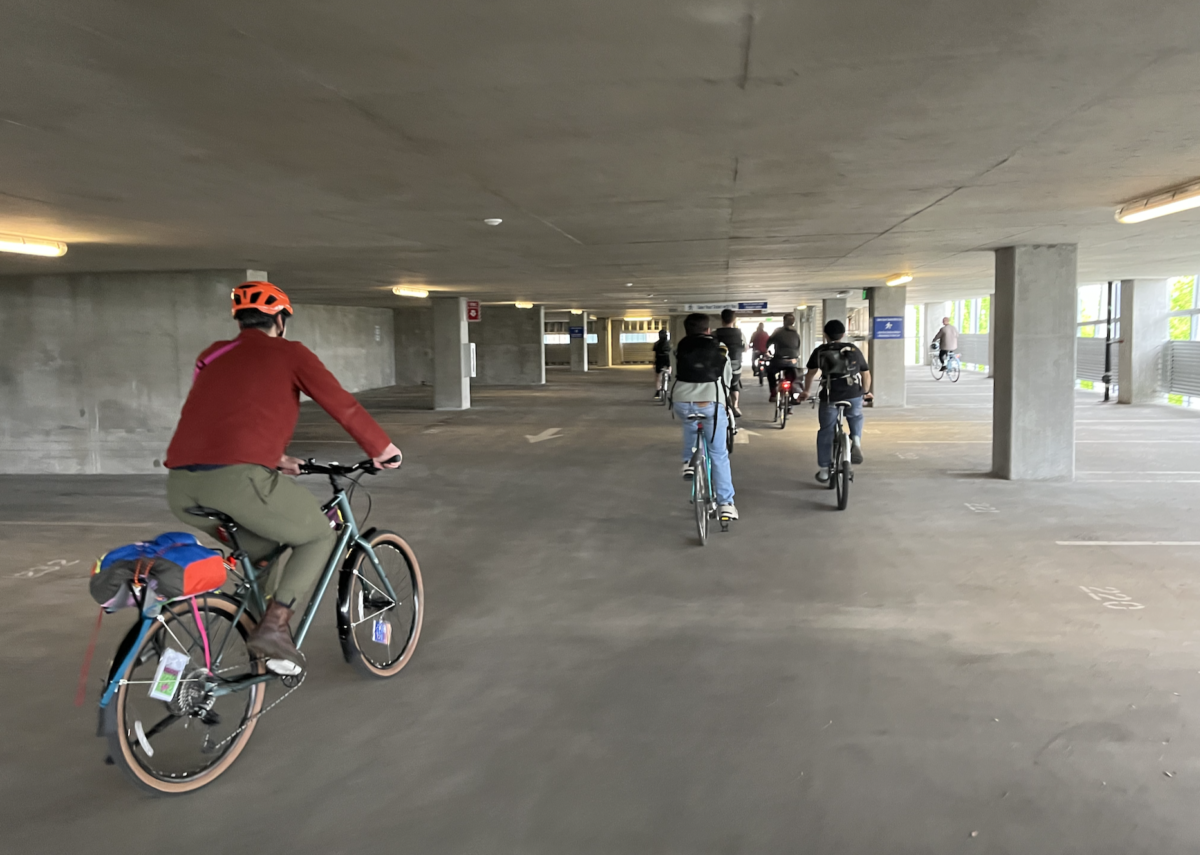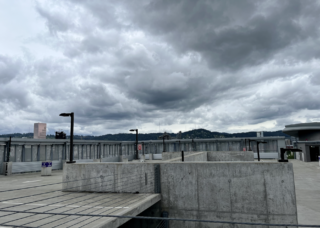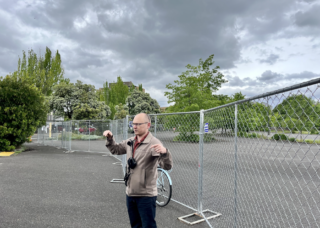
Car parking has a unique place in the modern American cultural zeitgeist. How often do you hear people brag about or bemoan their parallel parking skills or complain about the hellscape of the Trader Joe’s parking lot? Considering how much money and effort goes into planning and building parking structures and spaces, it makes sense how much we talk about it.
Despite its real estate in our brains, however, the average American hasn’t taken a real peek behind the parking curtain. On Bike Loud PDX’s latest policy ride hosted by their west chapter, local parking guru Tony Jordan aimed to share what lies beneath the asphalt surface of car parking in Portland.
In several stops throughout the central city, we toured facilities that have a total of nearly 5,500 car parking spaces.
Jordan presides over the Parking Reform Network, a Portland-based non-profit with a mission to educate the public about the impact parking has on our society and create policy change. Last Friday, he led a group bike ride around downtown and the Lloyd, taking participants on an odyssey of Portland parking history.
Advertisement
[Video below is a recap of the ride by Amit Zinman.]

I had some insight into parking policy going into the ride, especially after I heard Jordan speak alongside other parking experts at last month’s YIMBYtown conference. But it was a different experience to see how these plans play out in real life. As we made our way around downtown, Jordan told stories about how car parking has shaped big parts of Portland’s DNA.
One place in downtown Portland impacted by the ills of parking is O’Bryant Square, which used to be an open plaza park and is now a fenced-off slab of concrete taking up space. The Portland Bureau of Transportation shut the plaza down in 2018 citing structural issues with the parking garage under the park, which would take a few million dollars to repair.
“It’s not necessarily the city’s priority to spend the money to rebuild that parking. So, instead of a park, we have a fenced off broken parking garage,” Jordan said.
Jordan led us across the river where we rode to the top of the (mostly empty) seven story Oregon Convention Center parking garage on NE Multnomah St and 2nd Ave. You get a pretty nice view of the city from that vantage point, as well as a concrete playground to ride around in, but is that really worth the $32 million it cost to build and the space it takes up today?

Advertisement
Among the many problems building abundant car parking creates is the central fact that more parking encourages more driving. The parking garage at the convention center is a good example of that: it’s located right across from the Hyatt Regency, which is mostly a place tourists stay. This area is perfectly accommodated by public transportation: the MAX red line from the airport essentially deposits you at the hotel door. But if you took the MAX, who would fill up all those lonely parking spots?

“Along with the MAX at the airport, they also have a hell of a lot of parking and car rental facilities,” Jordan said.
Instead of further investing in public transportation and encouraging people to use the transit we already have, building parking garages incentivizes driving cars and makes it seem necessary to have a car to get around when it’s really not.
After circling back down the empty parking garage, we headed over to the parking lot near Holladay Park right across from the Lloyd Center, where Sightline Institute author Michael Andersen briefly took over to share how the Lloyd Center’s abundant parking lots came to be.

Mall parking lots are pretty much the same everywhere: miserable mazes full of annoyed shoppers desperate to find the perfect place to store their car. Andersen shared a very interesting theory on the mall in American society as places where people can take a short respite from cars and pretend they live in walkable cities where the streets are lined with shops. He said malls are little villages “constructed in the middle of a circle of parking lots” that people drive to, park their cars, have fun in the mall and then drive home.
This ride was just a brief primer on parking policy in Portland, and there’s a lot more information lying beneath. But even a two hour policy ride has the power to open someone’s eyes to how much stock our city puts into parking and how impactful it is on everyone’s lives, even people who don’t drive cars.
The big takeaway? We don’t need more parking. And the more we build, the more we encourage people to continue driving cars.
“There’s enough parking that already exists to manage the demand we have now,” Jordan said. “So if you think the traffic we have right now should get worse, you should support more parking. If you think the traffic we have now is bad enough, then we do not need more parking! We already have enough.”
If you’re inspired to join one of Bike Loud’s policy rides throughout the city, keep an eye on our calendar or sign up for their monthly newsletter.


